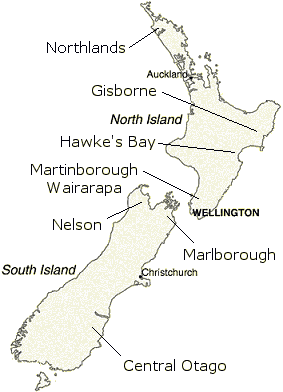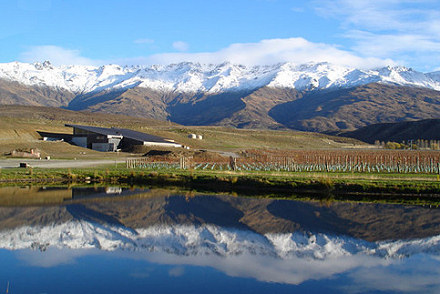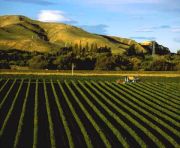
With its long narrow islands, New Zealand’s grape growing areas cover the length of the country. Whilst only a handful of regions enjoy world renown, there is quality across New Zealand, from Northlands at the tip of the North Island (latitude 35° S) down to the wineries of Central Otago (latitude 45° south), the latter enjoying huge growth and looking very exciting for Pinot Noir in particular.
Geography and climate
New Zealand – much to the chagrin of the Kiwis – is often lumped in with Australia, yet the twin islands lie some 1,250 miles southeast of Australia’s shores – about the same distance apart as London and St Petersburg, Russia. The North Island is famed for its volcanic mountains and its hot springs. The Southern Alps extend almost the entire length of the South Island, ending in deep fjords. Though there are huge contrasts – from sub tropical in the far north, to almost arctic in the highest areas of the south – New Zealand mostly enjoys a temperate, maritime climate. The sea has a strong influence on the country’s vineyards, which are mostly coastal. Warmth and sunlight is plentiful during the day, whilst nights are cooled by sea breezes. Many areas benefit from a long ripening season, not unlike the vineyards of Alsace.
Grapes
The single grape which has really put New Zealand on the world map is the Sauvignon Blanc. Sauvignons, particularly from Marlborough on the northern tip of the South Island, burst onto the world stage in the 1990’s. Oz Clarke raved about the wines in his Wine Atlas: ‘No previous wine had shocked, thrilled, entranced the world before with such brash, unexpected flavours of gooseberries, passionfruit and lime, or crunchy green asparagus spears’. Leader of the Sauvignon pack is Cloudy Bay, but a host of quality names are now familiar to wine-lovers worldwide.


New Zealand’s Bordeaux and Rhone-style red wines once had a reputation of being rather ‘green’ in flavour, but better viticultural practices mean that superb wines are now being produced by estates like Craggy Range, Esk Valley and Unison amongst many others.
The wines of New Zealand
New Zealand makes all styles of wines, including top quality sparkling wines to rival Champagne and botrytis ‘stickies’ to compete against the best Germany has to offer. But it is fair to say that until now New Zealand has carved out a niche for itself through its intensely fruity and vibrant dry whites, especially Sauvignon Blanc. The wines attract a premium, and most consumers are happy to pay £6 and upwards for a good example. Arguably these are the world’s greatest Sauvignons Blanc, preferred by many to the wines of Sancerre and Pouilly-Fumé, their famous French counterparts.
In the past few years New Zealand, like other New World wine producing nations, has started to pay more and more attention to identifying which regions are best suited to particular grape varieties and wine styles. This has led to a proposed Geographic Indications Act which will seek to classify wine producing areas, very like California’s ‘AVA’ system (American Viticultural Areas). An area called ‘Gimblett Gravels’ in Hawkes Bay claims to be the New World’s first wine region defined by terroir; the boundary is defined by soil type, not geography or politics.
Having recognised the quality of Marlborough Sauvignon Blanc in particular, the wine world is currently very excited by Pinot Gris and Pinot Noir from Central Otago, and Bordeaux blends from Hawkes Bay amongst others. A run-down of the major wine-producing areas, from north to south, follows:
Gisborne
This is New Zealand’s Chardonnay capital. First commercially planted in the 1920’s, this warm-climate area once had a reputation as a bulk wine producer. By the 60’s, many familiar names used Gisborne fruit to drive their operations, including Cooks, Montana and Corbans. Gisborne reduced its planted area massively in the 80’s with the aid of government cash. The Montana group still produces one of its best Chardonnays, ‘The Ormond’ from Gisborne fruit, but plantings of other varieties such as Chenin Blanc and Gewürztraminer have also increased.
Hawkes Bay

Martinborough
On the southern tip of the North Island, and just across the Cook Strait from Marlborough, Martinborough is also known as Wairarapa. A newer wine region than Hawkes Bay, Martinborough first found fame for its Pinots Noirs, from producers like Ata Rangi and Martinborough Vineyards. This is an extremely high quality area by and large, and seems equally suited to aromatic white varieties. The Dry River estate of Dr Neil McCallum has achieved something of a cult status for its Pinot Gris, Gewürztraminer and Rieslings, both dry and botrytised. Though quite expensive, I’ve rarely been disappointed by a wine from any of the producers mentioned, nor Palliser Estate, Walnut Ridge or Delamere.
Marlborough

The extraordinary intensity of the wines from this region was a revelation to many wine lovers and Marlborough Sauvignons are amongst the most distinctive of any wine styles. The 1985 vintage of Cloudy Bay’s Sauvignon was picked up by wine critics around the world, and there has been an extraordinary scramble for each new vintage ever since. Sparkling wines are also made here to very high quality, both by outposts of Champagne houses like Deutz, and locals like Cloudy Bay’s Pelorus. Other very fine producers include Isabel Estate, Lawson’s Dry Hills and Nautilus.
Central Otago
For me this is currently one of the most exciting areas in New Zealand, with a string of wonderful Pinots Noirs, Rieslings and Pinots Gris in the 1998 vintage from numerous estates. The most southerly of the major regions, the climate here is continental, with hotter summers, but cool nights and very cool winters. Felton Road (recently purchased by Englishman Nigel Greening) is perhaps the best producer of the region, but also of terrific quality are Mount Edward, Mount Difficulty and Gibbston Valley. There are notes on a dozen or so Otago wines from The New Zealand Wine Institute Tasting 2001.
Other wine making regions of note include Northlands and Auckland, hot-climate areas where Delgat’s and Selaks are amongst the best producers, the up and coming Canterbury and Waipara for Riesling and Pinot Noir in particular and Nelson, a decent all-rounder and something of a Riesling heaven, where Neudorf and Seifried are amongst my favourite estates.

